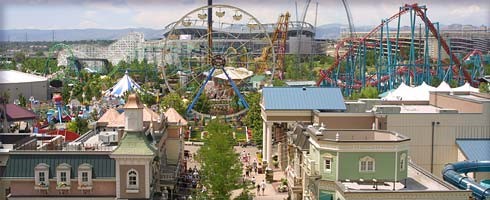Relocation of the 100-year old Elitch Gardens Amusement Park to a 68-acre site along the Platte River.
Elitch Gardens was one of the most popular entertainment destinations in Colorado for more than a century. A cultural touchstone since it opened in 1890 by John and Mary Elitch, the original park at 38th and Tennyson in northwest Denver was home to gardens, the historic Elitch Theatre at the Gardens (the first female-owned theater and longest standing summer stock theatre in the United States from 1897 – 1987), the famous Trocadero Ballroom (a regular stop and broadcasting venue for touring big bands), and numerous rides.
The City of Denver acquired Colorado & Southern’s Rice Yards in the early 1990s to facilitate the move, keep Elitch Gardens in Denver and fulfill the city’s vision for a redeveloped Central Platte River Valley (CPV). The vision, first laid out by Mayor Tom Currigan in response to the 1965 “Flood of the Century,” called for a mix of civic, entertainment and commercial uses. The redevelopment would also include a campus for higher education. In March 1977, Mayor McNichols and Denver City Council adopted a comprehensive plan for the Central Platte Valley. The plan paved the way for Mayor Currigan’s blueprint to become a reality, but it would take decades of effort to make it happen.
Like much of the CPV, the new Elitch Gardens site was environmentally contaminated and was declared a Superfund Site by the Environmental Protection Agency. The site also lacked public infrastructure. To help bring desired redevelopment, DURA created the Rice Yards Urban Renewal Area and issued $10.9 million in TIF bonds to help finance environmental remediation and other site-wide improvements.
The $95 million development of the new site began in 1994 and was completed in May 1995. Elitch Gardens relocated 15 of its 20 biggest rides to the new location and immediately saw a more than 25 percent increase in annual attendance to more than 1 million visitors a year. Through the combined efforts of the city, the developer and DURA, a key goal of the City’s plan for revitalizing the CPV was achieved, and today Elitch Gardens is one of the last center-city amusement parks left in the country.
DURA fully repaid the TIF bonds in 2008 – nine years ahead of schedule – and saved more than $5 million in scheduled debt service expenses. Taxes generated by the project now flow to the original taxing entities.
